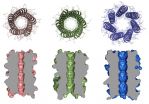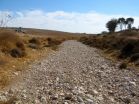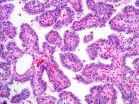(Press-News.org) Proteins are long linear molecules that fold up to form well-defined 3D shapes. These 3D molecular architectures are essential for biological functions such as the elasticity of skin, the digestion of food, and the transport of oxygen in blood.
Despite the wide variety of tasks that natural proteins perform, they appear to use only a limited number of structural types, perhaps just a few thousand or so. These are used over and over again, being altered and embellished through evolution to generate many different functions. This raises the question: are more protein structures possible than those used and presented to us by nature?
A team from Bristol's School of Chemistry and School of Biochemistry, headed by Professor Dek Woolfson, have addressed this by designing manmade protein molecules from scratch.
Although the design principles used are learnt from natural proteins, from which the team develops rules for assembling their proteins, some of the designed protein shapes are completely new and have not been observed in nature yet.
Specifically, the scientists have made proteins with central cavities, or channels, running through them. The team believes that these will be useful in designing new protein functions, such as catalysts for breaking down fats, or molecules that span cell membranes to allow new communications between cells.
Professor Woolfson said: "This is a really exciting time to be exploring what can be done with biological principles and building blocks to make new and useful molecules, but completely outside the context of biology itself. It is one aspect of the emerging field of synthetic biology, in which Bristol is taking a lead both nationally and internationally."
This work has been highly collaborative combining computational modelling, peptide chemistry, biophysics and protein X-ray crystallography across the Schools of Chemistry (Drew Thomson, Antony Burton, Gail Bartlett and Dek Woolfson) and Biochemistry (Richard Sessions and Leo Brady), and an South West Doctoral Training Partnership student (Chris Wood) working between the two Schools.
It is part of the growing effort in the new field of synthetic biology at the University of Bristol, which has recently been awarded £13.5 million to establish BrisSynBio, a BBSRC/EPSRC-funded Synthetic Biology Research Centre.
INFORMATION:
Paper
'Computational design of water-soluble α–helical barrels' by Thomson A.R. et al in Science
A Dartmouth study suggests that it may be possible to use Diffuse Optical Spectroscopic Tomographic imaging (DOST) to predict which patients will best respond to chemotherapy used to shrink breast cancer tumors before surgery. These findings could eliminate delays in effective early treatment for tumors unlikely to respond to neoadjuvant chemotherapy (NAC). The study, "Predicting breast tumor response to neoadjuvant chemotherapy with Diffuse Optical Spectroscopic Tomography prior to treatment," was published online in Clinical Cancer Research on October 7, 2014.
Breast ...
BOSTON - New achievements in synthetic biology announced today by researchers at the Wyss Institute for Biologically Inspired Engineering, which will allow complex cellular recognition reactions to proceed outside of living cells, will dare scientists to dream big: there could one day be inexpensive, shippable and accurate test kits that use saliva or a drop of blood to identify specific disease or infection — a feat that could be accomplished anywhere in the world, within minutes and without laboratory support, just by using a pocket–sized paper diagnostic ...
(Santa Barbara, Calif.) — Volatile rainstorms drive complex landscape changes in deserts, particularly in dryland channels, which are shaped by flash flooding. Paradoxically, such desert streams have surprisingly simple topography with smooth, straight and symmetrical form that until now has defied explanation.
That paradox has been resolved in newly published research conducted by Michael Singer and Katerina Michaelides, associate researchers at UC Santa Barbara's Earth Research Institute. The pair show that simple topography in dryland channels is maintained ...
DALLAS – Oct. 23, 2014 – A hormone seen as a popular target to develop weight-loss drugs works by directly targeting the brain and triggering previously unknown activity in the nervous system, UT Southwestern Medical Center obesity researchers have found.
The fibroblast growth factor 21 (FGF21) hormone has been a key target for developing weight-loss drugs because the protein increases energy expenditure, causing the body to burn calories. But how the hormone worked wasn't known until now.
UT Southwestern researchers tracking the hormone discovered that ...
DENVER – Sixteen institutions across Europe collaborated together to show for the first time that a semi-quantitative anaplastic lymphoma kinase (ALK) protein expression test, immunohistochemistry (IHC), is reliable amongst several laboratories and reviewers when test methodology and result interpretation are strictly standardized and the scoring pathologists are appropriately trained on the test.
ALK tyrosine kinase inhibitors (TKIs) shrink tumors and increase progression-free survival in late-stage non-small cell lung cancer (NSCLC) patients positive for ALK as ...
DENVER –CANARY, Computer-Aided Nodule Assessment and Risk Yield, is a novel software tool developed at Mayo Clinic that can automatically quantitate adenocarcinoma pulmonary nodule characteristics from non-invasive high resolution computed tomography (HRCT) images and stratify non-small cell lung cancer (NSCLC) patients into risk groups that have significantly different disease-free survival outcomes.
The majority of NSCLC patients are diagnosed with advanced-stage disease which is concomitant with an exceptionally poor prognosis, 5-year survival rate of 4%. In ...
In individuals living in the Arctic, researchers have discovered a genetic variant that arose thousands of years ago and most likely provided an evolutionary advantage for processing high-fat diets or for surviving in a cold environment; however, the variant also seems to increase the risk of hypoglycemia, or low blood sugar, and infant mortality in today's northern populations. The findings, published online October 23 in Cell Press's American Journal of Human Genetics, provide an example of how an initially beneficial genetic change could be detrimental to future generations. ...
People may have been making their way from Easter Island to the Americas well before the Dutch commander Jakob Roggeveen arrived with his ships in 1722, according to new genomic evidence showing that the Rapanui people living on that most isolated of islands had significant contact with Native American populations hundreds of years earlier. The findings reported in the Cell Press journal Current Biology on October 23 lend the first genetic support for such an early trans-Pacific route between Polynesia and the Americas, an impressive trek of more than 4,000 kilometers (nearly ...
Synthetic gene networks hold great potential for broad biotechnology and medical applications, but so far they have been limited to the lab. A study published by Cell Press October 23rd in the journal Cell reveals a new method for using engineered gene circuits beyond the lab, allowing researchers to safely activate the cell-free, paper-based system by simply adding water. The low-cost, easy-to-use platform could enable the rapid detection of different strains of deadly viruses such as Ebola.
"Our paper-based system could not only make tools currently only available ...
ANN ARBOR, Mich. — A new comprehensive analysis of thyroid cancer from The Cancer Genome Atlas Research Network has identified markers of aggressive tumors, which could allow for better targeting of appropriate treatments to individual patients.
The finding suggests the potential to reclassify the disease based on genetic markers and moves thyroid cancer into a position to benefit more from precision medicine.
"This understanding of the genomic landscape of thyroid cancer will refine how it's classified and improve molecular diagnosis. This will help us separate ...




